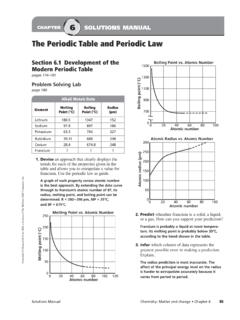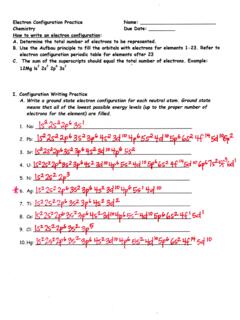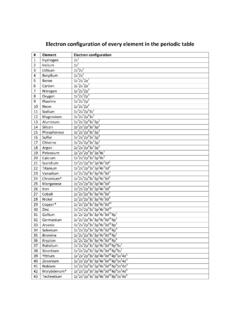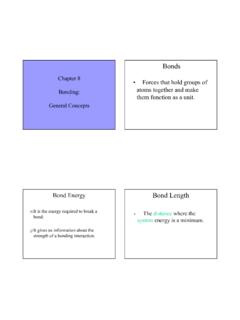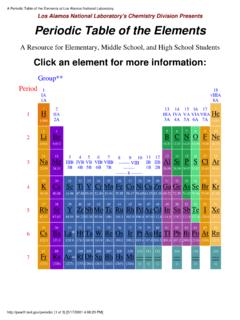Transcription of QUANTUM NUMBERS WORKSHEET answers
1 QUANTUM NUMBERS WORKSHEET 1. State the four QUANTUM NUMBERS , then explain the possible values they may have and what they actually represent. n Pricipal QUANTUM Number: represents the energy level the electron is in, linked to the periods of the periodic . Can be 1 to 7 l Secondary QUANTUM Number/Orbital Shape QUANTUM number: represents the shape of the orbital- s, p, f, d. l is a range of n-1. ml Magnetic QUANTUM number: represents the number of orbits possible. Ml is a range of l. ms Spin QUANTUM number: represents the electron and its spin. Two possibilities +1/2, -1/2 2.
2 State the number of possible electrons described by the following QUANTUM NUMBERS a. n = 3, l = 0 2 b. n = 3, l = 1 6 c. n = 3, l = 2, ml = -1 2 d. n = 5, l = 0, ml -2, ms -1/2 Not possible 3. Give the n and l values for the following orbitals a. 1s n=1 l = 0 b. 3s n=3 l =0 c. 2p n= 2 l= 1 d. 4d n= 4 l=2 e. 5f n= 5 l= 3 4. What is the ml values for the following types of orbitals? a. s ml= 0 b. p ml= -1, 0,1 c. d ml= -2, -1, 0, 1, 2 d. f ml= -3, -2, -1, 0, 1, 2, 3 6. How many possible orbitals are there for n = a.
3 4 s-1, p-3, d-5, f-7= 16 orbitals b. 6 9 orbitals 7. Write the complete set of QUANTUM NUMBERS that represent the valence electrons for the following elements: a. He n=1, l= 0, ml= 0, ms=+1/2 n=1, l= 0, ml= 0, ms=-1/2 b. V n=4, l=0, ml= 0, ms= +1/2 n=4, l=0, ml= 0, ms= -1/2 c. Ni n=4, l=0, ml= 0, ms= +1/2 n=4, l=0, ml= 0, ms= -1/2 d. Cu n=4, l=0, ml= 0, ms= +1/2 n=4, l=0, ml= 0, ms= -1/2 e. Br n=4, l=0, ml = 0, ms= +1/2 n=4, l=0, ml = 0, ms= -1/2 n=4, l=1, ml = -1, ms= +1/2 n=4, l=1, ml = 0, ms= +1/2 n=4, l=1, ml = 1, ms= +1/2 n=4, l=1, ml = -1, ms= -1/2 n=4, l=1, ml = 0, ms= -1/2 8.
4 Write the electron configurations for the elements above. He= 1s2 V [Ar] 4s23d3 Ni [Ar] 4s23d8 Cu [Ar] 4s23d9 Br [Ar] 4s23d104p5 9. Without referring to a text, periodic table or handout, deduce the maximum number of electrons that can occupy an: a. s orbital _2__ b. the subshell of p orbitals __6___ c. the subshell of d orbitals _10__ d. the subshell of f orbitals__14__ e. the subshell of g orbitals__18__ 10. How many electrons can inhabit all of the n=4 orbitals? 4s = 2 4p = 6 4d = 10 4f = 14 32 Total Electrons 11. Fill in the blanks with the correct response: a.
5 The number of orbitals with the QUANTUM NUMBERS n=3, l=2 and ml = 0 is ___1___. b. The subshell with the QUANTUM NUMBERS n=4, l=2 is ___d__. c. The ml values for a d orbital are ___-2, -1, 0 , 1, 2_____. d. The allowed values of l for the shell with n=2 are ____0, 1___. e. The allowed values of l for the shell with n=4 are ___0, 1, 2, 3___. f. The number of orbitals in a shell with n=3 is __1+3+5=9_(s, p, d)__. g. The number of orbitals with n=3 and l=1 is __3____. h. The maximum number of electrons with QUANTUM NUMBERS with n=3 and l=2 is __10__. i. When n=2, l can be __0, 1__.
6 J. When n=2, the possible values for ml are __-1, 0, 1____. k. The number of electrons with n=4, l=1 is __6__. l. The subshell with n=3 and l=1 is designated as the __p or -1, 0, 1___ subshell. m. The lowest value of n for which a d subshell can occur is n=___3__. 12. Write the values for the QUANTUM NUMBERS for the bold electron in the following diagrams: a. 3p orbitals c. 4d orbitals a. n=3, l=1, ml =1, ms =+1/2 c. n=4, l=2, ml = - 2, ms = - 1/2 b. 5s d. 3d orbitals b. n=5, l=0, ml =0, ms = - 1/2 d. n=3, l=2, ml =0, ms =+1/2 13.
7 How many electrons can occupy any single subshell orbital? 2__ 14. a. What is the value of l for a 4 f electron ? 3 b. What is the orbital designation for an electron in the 3rd shell and p sublevel? 3p c. What are the possible values of ml for a 5d electron ? 2, 1, 0, -1, -2 d. What is the maximum number of electrons in the 3rd energy level? 18 e. How many orbitals have the following QUANTUM NUMBERS : n =4, l = 2, ml = -2? 1 f. How many electrons have the following QUANTUM NUMBERS : n =4, l = 2, ml = -2? 2


